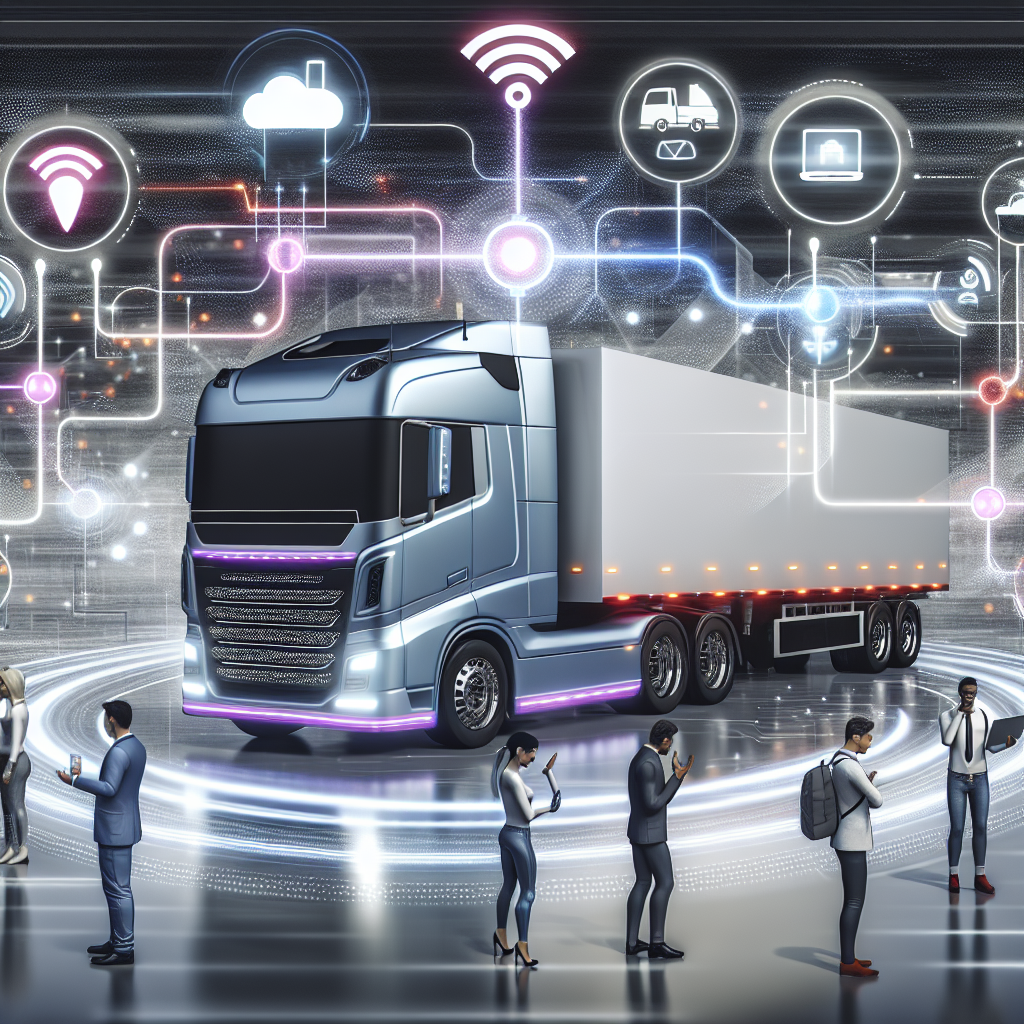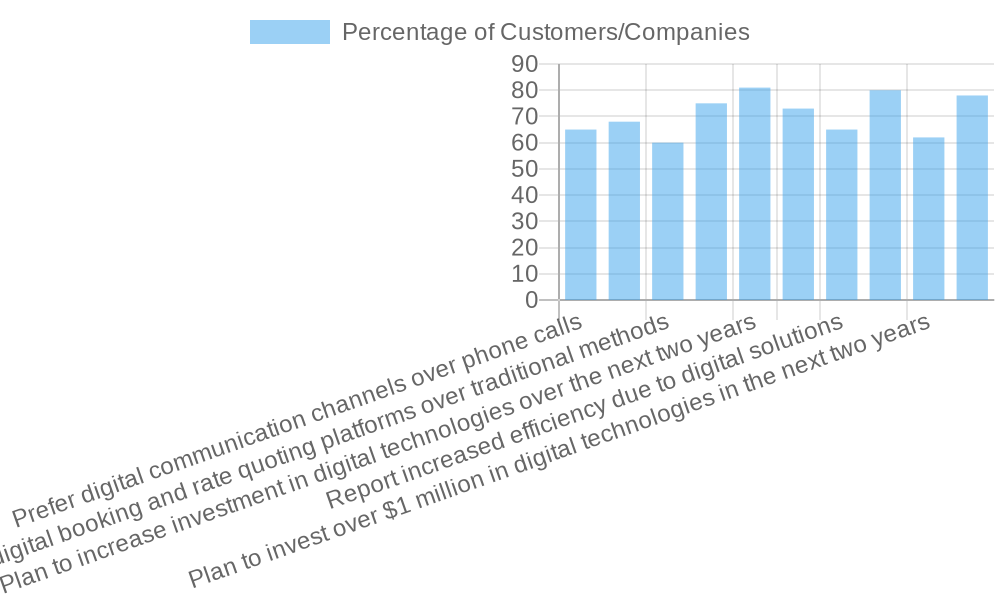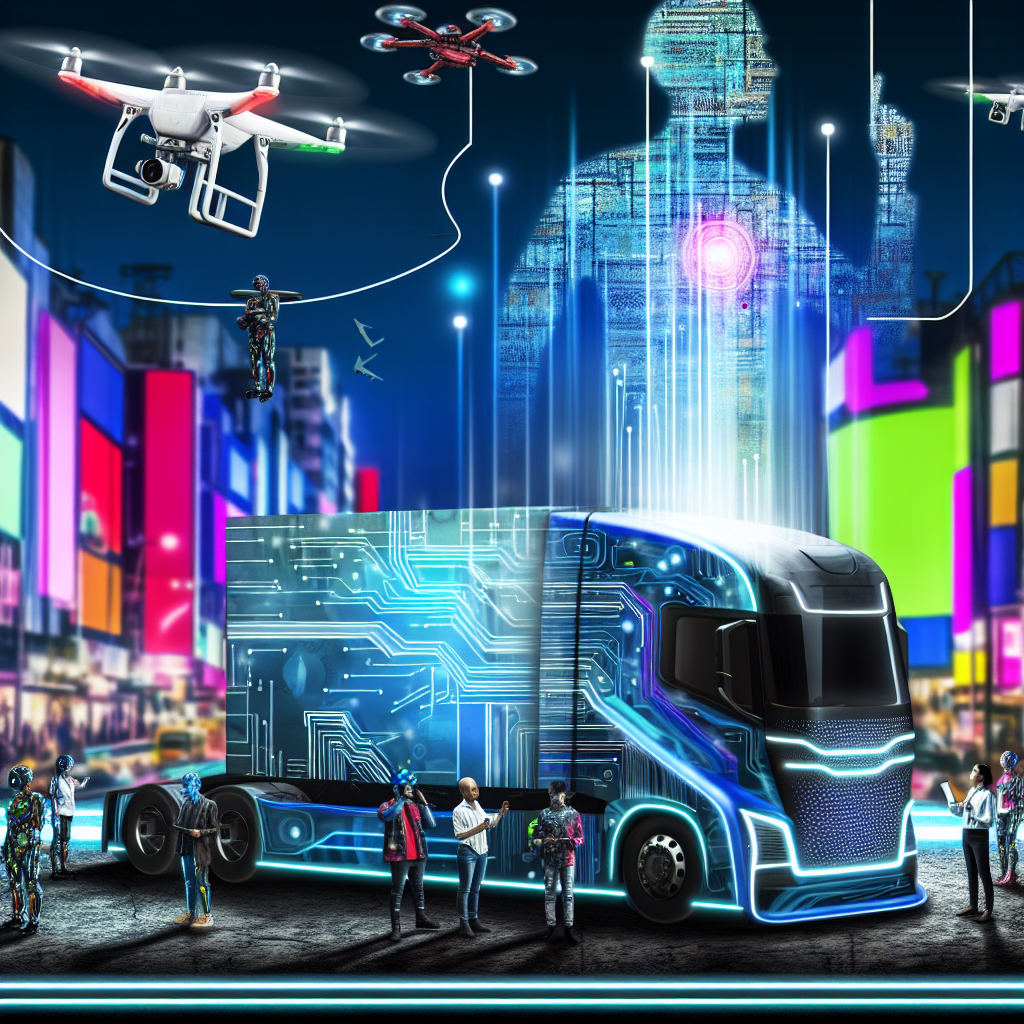As the trucking industry undergoes remarkable digital transformation, the rapid integration of advanced technologies is reshaping operations and redefining customer service. However, amidst this whirlwind of innovation, a critical challenge emerges: how to strike the right balance between cutting-edge technology and the invaluable human element.
At the heart of this dilemma lies the concept of investing in people. This approach encourages companies to recognize that while digital tools streamline processes, it is the people—those who master these tools and engage with customers—that truly drive success. In an era where 30% of customers still prefer the familiarity of phone conversations over digital interactions, the importance of nurturing human talent cannot be overstated.
True excellence in customer service hinges on a strategy that weaves together technological prowess with a deep commitment to developing and empowering the workforce. Embracing this dual focus is essential for companies aiming to thrive in an ever-evolving marketplace.
Recent statistics underscore the ongoing preference among trucking customers for traditional communication methods, particularly phone calls, over an exclusively digital approach. Here are some pertinent data points:
- 65% of customers now favor digital channels for service inquiries.
- 58% human interaction is still preferred by smaller trucking companies, compared to 42% technology.
- 82% of customers exhibit increased trust in carriers with timely updates about their shipments.
Overall, while the trend toward digital communication is clear, the importance of face-to-face interactions and personal contact should not be underestimated. As the trucking industry continues evolving with digital innovations, organizations must invest in their people to ensure that they remain attuned to customer needs and preferences. This balance will ultimately lead to operational success and enhanced customer service.
Therefore, executives’ call to invest in people rather than solely on digital tools resonates strongly with these findings, highlighting the need for a well-rounded approach that nurtures both technological proficiency and human-centered service.
This dual focus not only enhances customer relationships but fosters a culture that prioritizes adaptability and empathy within the workforce.

In the trucking industry, investing in employee training and upskilling plays a pivotal role in driving customer satisfaction and achieving service excellence. By prioritizing training, companies equip their workforce with essential skills to navigate complex logistics and address customer concerns effectively. This proactive approach not only enhances individual competence but also fosters a culture of continuous improvement. Cross-training, in particular, emerges as a vital strategy, allowing employees to gain insights into different roles within the organization. This versatility empowers staff to respond more effectively to customer needs, streamline operations, and ensure that service delivery remains seamless even in dynamic situations. Moreover, businesses that invest in training initiatives find themselves better positioned to retain talent, as employees feel valued and supported in their professional growth. Ultimately, organizations that recognize the importance of comprehensive training and cross-training are more likely to create a supportive environment that translates into exceptional customer service and long-term client loyalty.
This unwavering commitment to employee development not only serves current business needs but prepares the workforce for future challenges, making it an indispensable component of a company’s operational strategy.
As the industry’s landscape continues to evolve, prioritizing training will remain fundamental for maintaining a competitive edge in customer service, ensuring that staff are not only knowledgeable but also engaged and motivated to deliver excellence in every interaction with clients.
| Company | Employee Training Initiatives | Technology Adoption | Customer Satisfaction Ratings |
|---|---|---|---|
| Innocon | Cross-training every three months, employee flexibility training | Online ordering platform with traditional alternatives | Personal touch to meet diverse customer needs |
| TFI International | AI-driven procedures for onboarding, minimizing training times | AI tools for operational efficiency | Reliable service delivery improving satisfaction |
| Purolator | Automation reducing training times dramatically, VR for task training | Advanced technologies for sorting and routing | Ranked among Forbes’ top five Canadian employers, correlating with high customer satisfaction |
| Preferred Towing | Adaptable training to generational differences, supporting work-life balance | Dispatch systems for job tracking and truck matching | Focused on supportive culture leading to responsive service |
The current workforce is experiencing significant generational shifts that profoundly affect employee morale. As organizations navigate the complexities of a multigenerational environment, it becomes essential to recognize the distinct values and expectations each generation brings. Younger employees are increasingly looking for meaningful work and supportive environments that resonate with their ideals, while more seasoned employees often emphasize job stability and the value of their experience.
This generational diversity demands that companies adapt their people management strategies to meet varying employee needs effectively. By investing in people, organizations not only facilitate a sense of belonging and appreciation among their workforce but also foster a motivated culture capable of enhancing productivity and collaboration.
Companies that prioritize these aspects will likely see improved morale, reduced turnover, and a more engaged workforce that is better equipped to meet the challenges of a fluid market. Thus, aligning strategies to embrace this diversity through proactive engagement can lead to exceptional results in employee satisfaction and retention, underscoring the critical importance of investing in people as a fundamental business strategy.
Expert Insights on Investing in People
Here are some key insights from industry experts that highlight the importance of investing in people alongside technological advancements:
- David Kelly, president of Innocon, said, “Some just don’t want to use digital tools. Forcing technology on them risks losing business.” This statement emphasizes the need for balance in adopting technology and respecting customer preferences.
- Kristen Fess, executive vice-president at TFI, noted, “It’s a long game… Agility builds through repeated exposure to new experiences.” This highlights how ongoing training and diverse experiences are vital for increasing workforce agility.
- Jason Belgrave, director of operations at Purolator, observed, “The first instinct is to see automation as a way to cut costs. But it’s really about redeploying people into higher-value work.” This reflects a view that automation should support, not replace, the workforce’s contributions.
These insights collectively reinforce the message that technology and investment in human talent must go together for growth and exceptional customer service in trucking.
Automation in the Trucking Industry
Automation in the trucking industry is significantly transforming training processes and customer service, leading to notable reductions in training durations and enhancements in service quality.
Reduction in Training Times:
- Virtual Reality (VR) Training: The adoption of VR training in trucking has increased by 35% over the past three years. This immersive technology allows drivers to experience realistic scenarios, effectively reducing the time required to achieve proficiency.
- AI-Powered Training Tools: The use of AI-powered training tools in transportation has risen by 65% from 2020 to 2023. These tools provide personalized learning experiences, enabling drivers to grasp complex systems more quickly and efficiently.
Enhancements in Customer Service:
- AI Chatbots in Customer Support: Integrating AI chatbots into customer support can cut operational costs by 30%. Companies that successfully deploy these bots report significant improvements in response times, often reducing average resolution time from hours to mere minutes.
- AI-Driven Route Optimization: AI-powered route optimization reduces delivery times by an average of 15%. This efficiency leads to faster deliveries and improved customer satisfaction.
- AI-Based Scheduling Tools: AI-based scheduling tools have increased on-time delivery rates by 12%, enhancing customer satisfaction.
These advancements underscore the pivotal role of automation in streamlining training processes and elevating customer service standards within the trucking industry.
In conclusion, the trucking industry stands at a pivotal crossroads where the effective integration of technology and investment in human capital is not just a strategy but a necessity for long-term success. As we have discussed, embracing this balance is essential for thriving in today’s competitive landscape. It’s clear that fleets must prioritize a dual approach that values not only cutting-edge digital tools but also the essential skills and contributions of their workforce.
Furthermore, investing in training and employee engagement fosters a resilient culture that enhances both customer service and operational efficiency. This dual strategy, highlighted throughout the article, underscores that while technology streamlines processes, it is the people who ultimately drive this advancement forward. We urge trucking companies to understand that their workforce is the true engine of progress and a fundamental asset in any technological initiative.
As we look toward the future, the long-term benefits of such an approach are evident: heightened customer loyalty, improved employee morale, and a reputation for reliability that distinguishes a company in a crowded marketplace. Thus, the future of trucking hinges not solely on the latest technology but also on the people who harness these advancements to deliver exceptional service. Let us commit to investing in both technology and people, paving the way for a thriving industry that meets the evolving needs of today and tomorrow.


Balancing Technology and the Human Element in the Trucking Industry
As the trucking industry undergoes remarkable digital transformation, the rapid integration of advanced technologies is reshaping operations and redefining customer service. However, amidst this whirlwind of innovation, a critical challenge emerges: how to strike the right balance between cutting-edge technology and the invaluable human element. At the heart of this dilemma lies the concept of investing in people. This approach encourages companies to recognize that while digital tools streamline processes, it is the people—those who master these tools and engage with customers—that truly drive success. In an era where 30% of customers still prefer the familiarity of phone conversations over digital interactions, the importance of nurturing human talent cannot be overstated.
True excellence in customer service hinges on a strategy that weaves together technological prowess with a deep commitment to developing and empowering the workforce. Embracing this dual focus is essential for companies aiming to thrive in an ever-evolving marketplace. This is particularly relevant within the realm of trucking logistics, where the ongoing digital transformation shapes not only operational efficiencies but also employee training in logistics.
Recent Statistics on Customer Preferences
Recent statistics underscore the ongoing preference among trucking customers for traditional communication methods, particularly phone calls, over an exclusively digital approach. Here are some pertinent data points:
- 65% of customers now favor digital channels for service inquiries.
- 58% human interaction is still preferred by smaller trucking companies, compared to 42% technology.
- 82% of customers exhibit increased trust in carriers with timely updates about their shipments.
Overall, while the trend toward digital communication is clear, the importance of face-to-face interactions and personal contact should not be underestimated. As the trucking industry continues evolving with digital innovations, organizations must invest in their people to ensure that they remain attuned to customer needs and preferences. This balance will ultimately lead to operational success and enhanced customer service.
Executive Insights
Therefore, executives’ call to invest in people rather than solely on digital tools resonates strongly with these findings, highlighting the need for a well-rounded approach that nurtures both technological proficiency and human-centered service. In this landscape, employee training in logistics becomes critically important, offering proactive solutions that empower staff in a tech-driven environment.
The Role of Training in the Trucking Industry
In the trucking industry, investing in employee training and upskilling plays a pivotal role in driving customer satisfaction and achieving service excellence. By prioritizing training, companies equip their workforce with essential skills to navigate complex logistics and address customer concerns effectively. This proactive approach not only enhances individual competence but also fosters a culture of continuous improvement.
Cross-training, in particular, emerges as a vital strategy, allowing employees to gain insights into different roles within the organization. This versatility empowers staff to respond more effectively to customer needs, streamline operations, and ensure that service delivery remains seamless even in dynamic situations. Moreover, businesses that invest in training initiatives find themselves better positioned to retain talent, as employees feel valued and supported in their professional growth. Ultimately, organizations that recognize the importance of comprehensive training and cross-training are more likely to create a supportive environment that translates into exceptional customer service and long-term client loyalty.
This unwavering commitment to employee development not only serves current business needs but prepares the workforce for future challenges, making it an indispensable component of a company’s operational strategy, especially in a rapidly changing field like trucking logistics.
As the industry’s landscape continues to evolve under the influence of digital transformation in trucking, prioritizing training will remain fundamental for maintaining a competitive edge in customer service, ensuring that staff are not only knowledgeable but also engaged and motivated to deliver excellence in every interaction with clients.
Company Training and Technology Utilization
| Company | Employee Training Initiatives | Technology Adoption | Customer Satisfaction Ratings |
|---|---|---|---|
| Innocon | Cross-training every three months, employee flexibility training | Online ordering platform with traditional alternatives | Personal touch to meet diverse customer needs |
| TFI International | AI-driven procedures for onboarding, minimizing training times | AI tools for operational efficiency | Reliable service delivery improving satisfaction |
| Purolator | Automation reducing training times dramatically, VR for task training | Advanced technologies for sorting and routing | Ranked among Forbes’ top five Canadian employers, correlating with high customer satisfaction |
| Preferred Towing | Adaptable training to generational differences, supporting work-life balance | Dispatch systems for job tracking and truck matching | Focused on supportive culture leading to responsive service |
The Impact of Generational Shifts on Employee Morale
The current workforce is experiencing significant generational shifts that profoundly affect employee morale. As organizations navigate the complexities of a multigenerational environment, it becomes essential to recognize the distinct values and expectations each generation brings. Younger employees are increasingly looking for meaningful work and supportive environments that resonate with their ideals, while more seasoned employees often emphasize job stability and the value of their experience. This generational diversity demands that companies adapt their people management strategies to meet varying employee needs effectively.
By investing in people and promoting employee training in logistics, organizations not only facilitate a sense of belonging and appreciation among their workforce but also foster a motivated culture capable of enhancing productivity and collaboration. Companies that prioritize these aspects will likely see improved morale, reduced turnover, and a more engaged workforce that is better equipped to meet the challenges of a fluid market. Thus, aligning strategies to embrace this diversity through proactive engagement can lead to exceptional results in employee satisfaction and retention, underscoring the critical importance of investing in people as a fundamental business strategy.
Expert Insights on Investing in People
To emphasize the importance of investing in people alongside technological advancements, here are some notable insights from industry experts:
- David Kelly, president of Innocon, remarked, “Some just don’t want to use digital tools. By forcing technology on them, it risks losing business.” This statement highlights the need for balance in technology adoption and ensuring that customer preferences are respected.
- Kristen Fess, executive vice-president at TFI, articulated, “It’s a long game… agility is built through repeated exposure to new experiences.” This underscores how ongoing training and exposure to diverse roles are vital for developing agility within a workforce.
- Jason Belgrave, director of operations at Purolator, pointed out that “The first instinct is to see automation as a way to cut costs. But it’s really about redeploying people into higher-value work.” This reflects the view that automation should enhance, not replace, the workforce’s value.
These insights collectively reinforce the article’s message that technological progress must go hand in hand with investing in human talent to ensure comprehensive growth and exceptional customer service in the trucking industry. Furthermore, as automation continues to reshape training and operational processes, organizations must remain vigilant in nurturing their workforce, recognizing that these investments will yield dividends in customer loyalty and operational excellence.
The Role of Automation in Training and Customer Service
Automation in the trucking industry is significantly transforming training processes and customer service, leading to notable reductions in training durations and enhancements in service quality.
Reduction in Training Times:
- Virtual Reality (VR) Training: The adoption of VR training in trucking has increased by 35% over the past three years. This immersive technology allows drivers to experience realistic scenarios, effectively reducing the time required to achieve proficiency.
- AI-Powered Training Tools: The use of AI-powered training tools in transportation has risen by 65% from 2020 to 2023. These tools provide personalized learning experiences, enabling drivers to grasp complex systems more quickly and efficiently.
Enhancements in Customer Service:
- AI Chatbots in Customer Support: Integrating AI chatbots into customer support can cut operational costs by 30%. Companies that successfully deploy these bots report significant improvements in response times, often reducing average resolution time from hours to mere minutes.
- AI-Driven Route Optimization: AI-powered route optimization reduces delivery times by an average of 15%. This efficiency leads to faster deliveries and improved customer satisfaction.
- AI-Based Scheduling Tools: AI-based scheduling tools have increased on-time delivery rates by 12%, enhancing customer satisfaction.
These advancements underscore the pivotal role of automation in streamlining training processes and elevating customer service standards within the trucking industry. As technology continues to evolve, investing in advanced employee training in logistics will remain crucial to leverage these tools effectively and maintain high customer satisfaction.
Conclusion
In conclusion, the trucking industry stands at a pivotal crossroads where the effective integration of technology and investment in human capital is not just a strategy but a necessity for long-term success. To thrive in today’s competitive landscape, fleets must embrace a balanced approach that values both cutting-edge digital tools and the essential skills of their workforce. Investing in training and employee engagement not only builds a resilient culture but also enhances customer service and operational efficiency.
We urge trucking companies to prioritize this dual strategy, understanding that the workforce is the driving force behind any technological advancement. The long-term benefits of such an approach are clear: enhanced customer loyalty, improved employee morale, and a reputation for reliability that sets a company apart. The future of trucking is not solely about the latest technology but about the people who harness these advancements to deliver exceptional service. Let’s commit to investing in both technology and people, paving the way for a thriving industry that meets the needs of today and tomorrow.
Understanding Customer Preferences
The analysis of the current trends in customer communication sheds light on the preferences among trucking customers, particularly regarding traditional methods versus digital approaches.
The Role of Employee Training
The significance of employee training cannot be overstated as it drives customer satisfaction and operational excellence. Companies that focus on training their workforce can navigate the complexities of logistics and customer interactions more effectively.
Addressing Generational Shifts
Recognizing the generational shifts within the workforce is crucial for companies aiming to maintain high employee morale and productivity. Understanding the unique values that each generation brings can help organizations foster a supportive and engaged workplace.
Expert Insights on Investment Strategies
Insights from key industry experts emphasize the balance needed between technology and human investment, further illustrating the importance of nurturing both elements to achieve success.
The Impact of Automation
Discussing how automation reshapes training and enhances service quality, and looking at significant reductions in training times thanks to emerging technologies, is crucial for understanding current advancements.
Conclusion: A Dual Approach for Future Success
In conclusion, reestablishing the call for a balanced integration of technology and human capital investment illustrates the future trajectory of the trucking industry. This dual focus encapsulates the essence of striving for operational excellence and exceptional service delivery in a competitive landscape.
